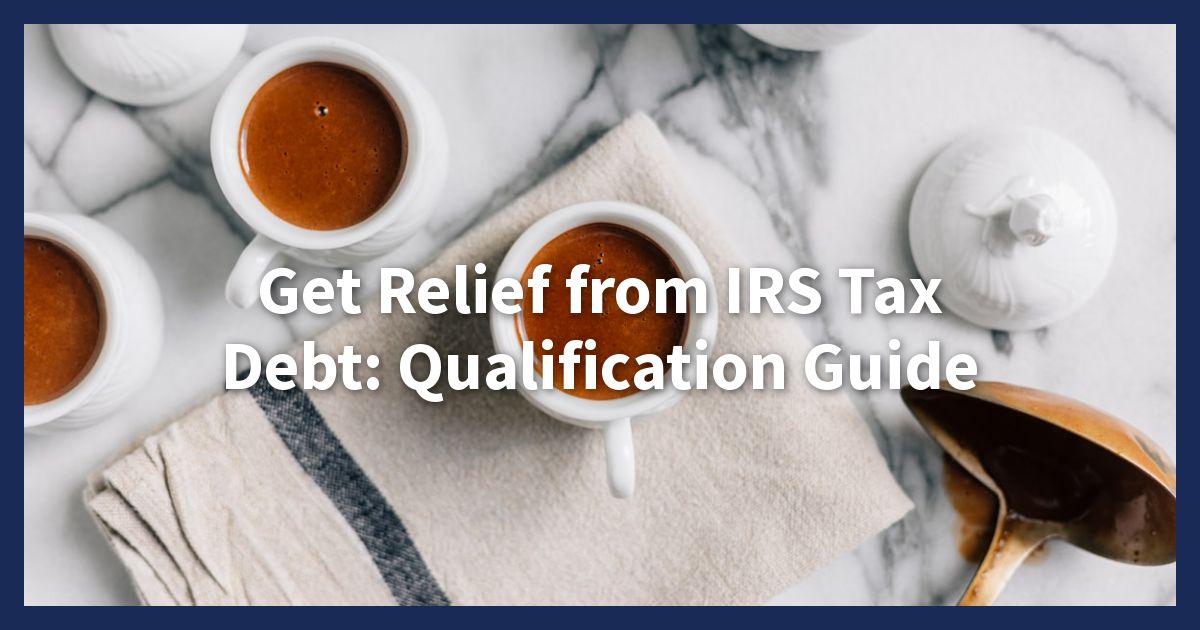Understanding how to qualify for the IRS Tax Debt Relief Program can be a game-changer for your financial situation. Fortunately, the IRS offers options like the Offer in Compromise program, allowing you to settle your tax debt for less than the full amount owed.
Dealing with tax debt can be overwhelming, but with the right knowledge and guidance, you can navigate the process effectively. The IRS provides assistance for taxpayers facing financial hardship, making it pivotal to explore relief options tailored to your specific situation.
By delving into the IRS Debt Forgiveness Program, individuals experiencing extreme financial hardship may find a path to resolving their tax liabilities. This program may offer a seamless solution for those who qualify, providing a much-needed sense of financial relief.
Embarking on the journey to resolve your tax debt requires proactive steps and a clear understanding of the options available. With the IRS tax relief programs, you can take the first step towards a more stable financial future.
Understanding the IRS Tax Debt Relief Program
The IRS Tax Debt Relief Program is designed to assist individuals and businesses burdened by tax debt. Through this program, taxpayers can negotiate with the Internal Revenue Service to settle their tax liabilities under more manageable terms.
What is the IRS Tax Debt Relief Program
The IRS Tax Debt Relief Program offers taxpayers a chance to resolve their tax debts through various repayment options, such as installment agreements, offers in compromise, or currently not collectible status. It provides a lifeline for those struggling to pay off their tax debts in full, offering a structured approach towards settling what is owed to the IRS.
Benefits of Qualifying for the Program
Qualifying for the IRS Tax Debt Relief Program comes with several advantages. One of the primary benefits is the opportunity to significantly reduce the total amount owed to the IRS through negotiated settlements. Additionally, successful participation in the program can prevent harsh enforcement actions like wage garnishments or bank levies.
 Photo by Anna Nekrashevich
Photo by Anna Nekrashevich
Eligibility Criteria for IRS Tax Debt Relief
The IRS Tax Debt Relief Program provides assistance to individuals who are facing financial challenges in meeting their tax obligations. To qualify for this program, certain eligibility criteria must be met. Here are the key requirements:
Financial Hardship Requirements
Individuals seeking IRS tax debt relief must demonstrate they are experiencing significant financial hardship that makes it difficult for them to pay their tax debt. This may include unemployment, large medical expenses, or other circumstances that have resulted in financial strain.
 Photo by Monstera Production
Photo by Monstera Production
Filing Tax Returns
A crucial criterion for eligibility is being up to date with filing tax returns. To qualify for tax debt relief, individuals must have filed all required tax returns. Failure to file tax returns may impact eligibility for the program.
Extreme Financial Hardship Claims
In cases where individuals are facing extreme financial hardship, such as the threat of losing their home or inability to afford basic living expenses, the IRS may consider these circumstances when evaluating eligibility for tax debt relief.
For more information on tax debt relief eligibility criteria and the application process, refer to the IRS official website. Eligibility requirements may vary based on individual circumstances, so it is essential to understand the specific guidelines before applying for relief.
Explore the following :
- Get Ahead with Accredited Online Business Degree Programs
- Your Guide to Hiring the Best Houston Maritime Attorney
- Simplifying AARP Secondary Insurance to Medicare: Your Essential Guide
- Under standing Federal Insurance Contributions Act
Options Available for Tax Debt Relief
Tax debt can be a significant burden for individuals, but there are various options available to provide relief and help manage this financial obligation. Let’s explore some common avenues for tax debt relief:
Offer in Compromise
An Offer in Compromise (OIC) is a program that allows taxpayers to settle their tax debt for less than the full amount owed. It provides a legitimate opportunity to reach a compromise with the IRS and resolve the debt. To qualify for an OIC, taxpayers must meet specific criteria and demonstrate their inability to pay the full amount.
Payment Plans
Payment plans are arrangements made with the IRS to pay off tax debt over time. These plans allow taxpayers to spread their payments over a more extended period, making it easier to manage their financial obligations. Setting up a payment plan can help individuals avoid levies or garnishments by showing a commitment to resolving their tax debt.
Installment Agreements
An Installment Agreement is another option for individuals struggling to pay their tax debt in full. It allows taxpayers to make monthly payments until the debt is fully satisfied. By entering into an Installment Agreement with the IRS, individuals can avoid more severe collection actions and work towards becoming tax compliant.

Photo by Karolina Grabowska
Installment Agreements
Taxpayers facing IRS tax debt may find relief through Installment Agreements, which provide a structured repayment plan. These agreements allow individuals to manage their tax debt effectively by spreading payments over a set period.
Types of Installment Agreements
There are different types of Installment Agreements offered by the IRS, each with specific implications for taxpayers. The most common types include:
- Guaranteed Installment Agreement: Available for taxpayers who owe $10,000 or less and meet certain eligibility criteria.
- Streamlined Installment Agreement: Simplified process for those who owe between $10,000 and $50,000, with quicker approval and no requirement for financial statements.
- Partial Payment Installment Agreement: Suitable for taxpayers who can’t afford to pay the full amount, allowing them to make smaller payments based on their financial situation.
Understanding these variations helps individuals choose the most appropriate Installment Agreement based on their tax debt and financial capabilities.
Qualifying for Installment Agreements
To qualify for an Installment Agreement with the IRS, taxpayers need to meet specific eligibility criteria and follow essential steps:
- Eligibility Criteria:
- Individuals must be up to date with current tax filings.
- Total tax debt, including interest and penalties, should fall within the specified thresholds.
- Demonstrating inability to pay the full amount upfront due to financial constraints.
- Steps to Qualify:
- Submit Form 9465 or apply online through the IRS website.
- Provide detailed financial information to support the proposed installment payments.
- Await approval from the IRS, which typically reviews the application to ensure compliance with their guidelines.
By understanding the process and requirements for Installment Agreements, taxpayers can take proactive steps to address their IRS tax debt and work towards financial stability.
Currently Not Collectible Status
Individuals facing significant financial hardship may qualify for Currently Not Collectible (CNC) status. This status means that the IRS temporarily suspends collection activities due to the taxpayer’s inability to pay. While the debt does not go away, it provides relief by halting collection efforts until the individual’s financial situation improves.
Navigating tax debt relief options can be complex, but understanding these avenues can help individuals make informed decisions about managing their tax obligations effectively. Each option has its requirements and implications, so it’s essential to explore them thoroughly and seek professional advice when needed.
Learn more about tax debt relief options
Applying for IRS Tax Debt Relief
When applying for IRS Tax Debt Relief, it’s essential to follow the necessary steps and provide the required documentation to increase your chances of approval. Here’s what you need to know:
Steps to Apply for Tax Debt Relief
- Assess Your Eligibility: Before applying for IRS Tax Debt Relief, determine if you qualify for the program based on your financial situation and tax liabilities.
- Prepare Your Financial Information: Gather all relevant financial documents, such as income statements, tax returns, and asset information, to support your application.
- Fill Out the Necessary Forms: Complete the appropriate IRS forms for requesting tax relief, ensuring accuracy and completeness to expedite the process.
- Submit Your Application: Send your application for tax debt relief to the IRS along with all required documentation, either online or through mail, following the instructions provided.
Documentation Required
When applying for IRS Tax Debt Relief, you will need to provide the following documentation:
- Proof of Income: Recent pay stubs, W-2 forms, or income tax returns to verify your financial status.
- Asset Information: Details of assets such as property, vehicles, and investments to assess your overall financial situation.
- Tax Returns: Copies of past tax returns to demonstrate your tax liabilities and payment history.
- Financial Statements: Bank statements, retirement account details, and any other financial records that support your application.
By carefully following these steps and compiling the necessary documentation, you can streamline the process of applying for IRS Tax Debt Relief and improve your chances of receiving assistance in managing your tax obligations effectively.
Seeking Professional Help for Tax Debt Relief
When facing tax debt issues, seeking professional help can be crucial in navigating the complexities of the IRS Tax Debt Relief Program. Tax attorneys and Enrolled Agents are skilled professionals who can provide valuable assistance in resolving tax debt challenges efficiently.
Tax Attorneys and Enrolled Agents
Tax Attorneys are legal experts specializing in tax law, equipped to offer strategic guidance and representation in dealings with the IRS. They possess in-depth knowledge of tax codes and regulations, allowing them to devise personalized solutions tailored to your specific tax situation. Enrolled Agents, on the other hand, are federally-authorized tax practitioners who can represent taxpayers before the IRS. Their expertise in tax matters makes them valuable allies in negotiating tax debt relief options.
Benefits of Professional Assistance
Engaging the services of Tax Attorneys or Enrolled Agents can offer several advantages. These professionals can:
- Provide Legal Expertise: Tax Attorneys offer legal counsel and representation, ensuring your rights are protected throughout the tax debt relief process.
- Negotiate with the IRS: Professionals can communicate with the IRS on your behalf, negotiating settlements or installment agreements to resolve tax debts.
- Offer Strategic Guidance: Tax professionals can assess your financial situation and devise a customized plan to address tax liabilities effectively.
- Ensure Compliance: By working with experienced professionals, you can ensure compliance with tax laws and regulations, avoiding potential pitfalls or penalties.
Seeking professional help for tax debt relief not only eases the burden of dealing with complex tax issues but also increases the likelihood of achieving a favorable resolution with the IRS.
Maintaining IRS Tax Compliance After Relief
Now that you’ve qualified for the IRS Tax Debt Relief Program, it’s essential to understand the significance of maintaining tax compliance to avoid future debt issues. Let’s delve into the importance of compliance and strategies to prevent tax debt in the future.
Importance of Compliance
Staying compliant with IRS regulations is crucial even after receiving tax relief. Compliance ensures that you continue to meet your tax obligations, file returns on time, and pay any taxes owed promptly. By remaining compliant, you demonstrate your commitment to fulfilling your duties as a taxpayer, which can positively impact your financial standing and reputation.
Avoiding Future Tax Debt
To prevent future tax debts, it’s essential to stay organized with your financial records, keep track of deadlines for filing returns and making payments, and seek professional assistance if needed. Implementing a proactive approach to managing your taxes can help you stay ahead of any potential debt issues and maintain a good standing with the IRS.
Remember, maintaining tax compliance is an ongoing process that requires diligence and attention to detail. By staying proactive and informed about tax regulations, you can secure your financial stability and avoid facing tax debt challenges in the future.
 Photo by Anna Nekrashevich
Photo by Anna Nekrashevich
Conclusion
As you explore the process and requirements to qualify for the IRS Tax Debt Relief Program, it becomes evident that being informed and proactive are key elements in navigating this program successfully. Remember, seeking professional advice and assistance can significantly ease the application process and maximize your chances of qualifying for the relief you need.
In the complex world of taxes and debts, understanding your options and obligations is crucial. By following the guidelines and ensuring you meet all the necessary criteria, you can potentially alleviate the burden of tax debt and regain financial stability.
When dealing with tax-related matters, it’s always wise to stay updated with the latest tax regulations and seek guidance from IRS resources for the most accurate information. By staying informed and taking the necessary steps, you can work towards resolving your tax debt issues and securing your financial future.
Remember, each individual’s financial situation is unique, and the IRS Tax Debt Relief Program offers different solutions to address diverse needs. By assessing your circumstances, exploring available options, and seeking professional advice when needed, you can pave the way towards a more stable and stress-free financial future.
In the end, qualifying for the IRS Tax Debt Relief Program is a process that requires diligence, understanding, and compliance with the IRS guidelines. By taking the necessary steps and seeking expert guidance, you can navigate through the complexities of tax debt relief and work towards a brighter financial outlook.
